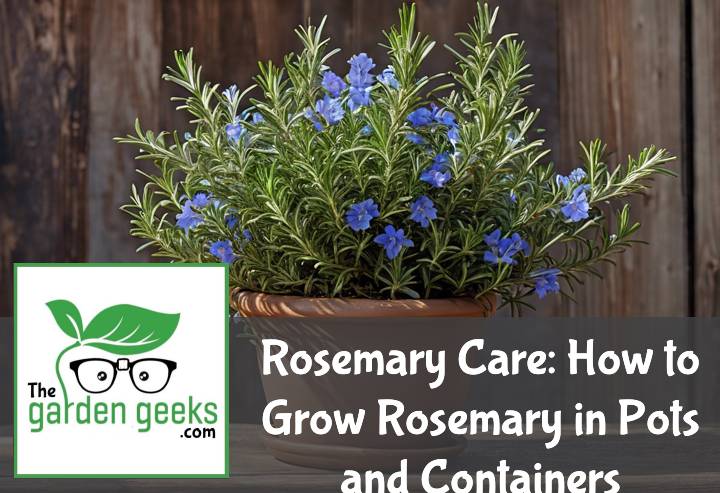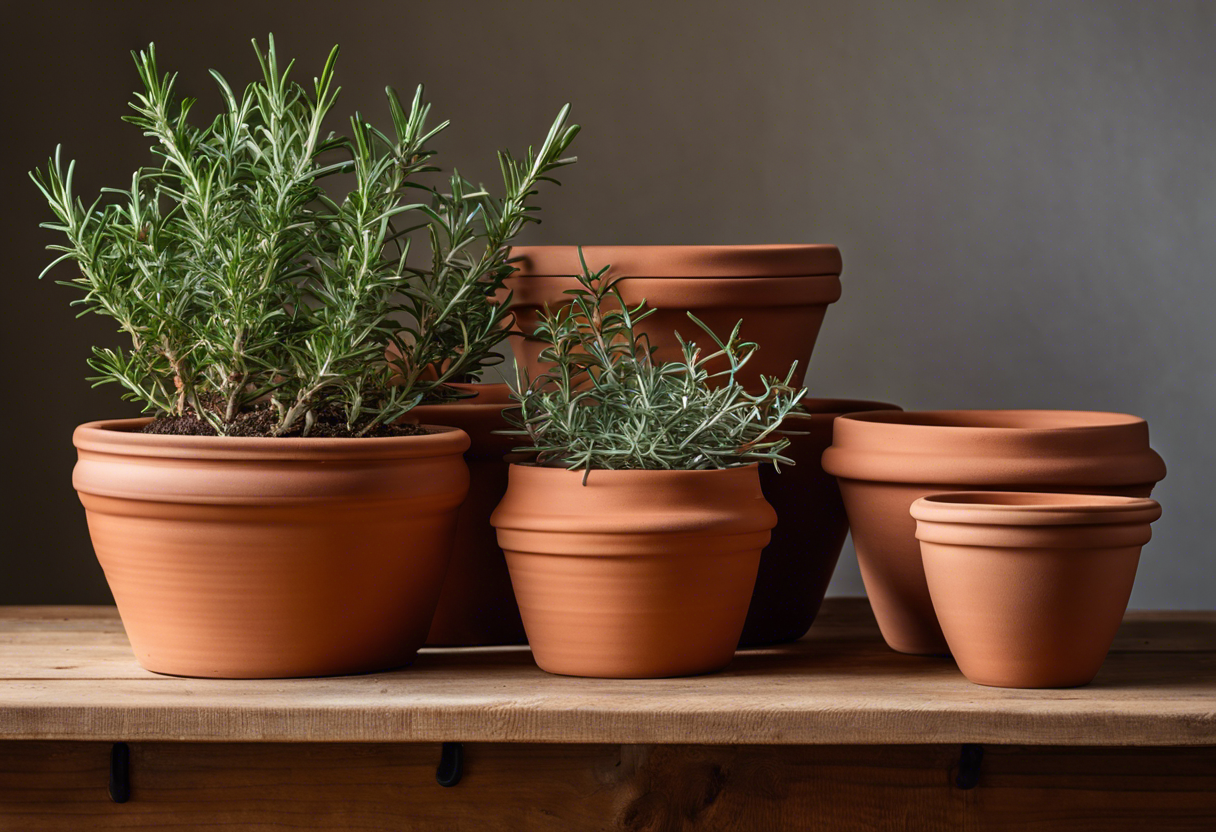Hello there, green thumb! Ever found yourself wishing for a sprig of rosemary to add some zing to your roast or stew? Well, guess what? You can have fresh rosemary right at your fingertips. And no, you don’t need a sprawling garden for it. All you need is a pot and some basic Rosemary Care knowledge.
Growing rosemary in pots or containers isn’t just convenient—it’s also rewarding. It’s like having your little Mediterranean corner right on your windowsill or patio. Plus, there’s something downright magical about seeing those tiny seeds transform into fragrant, needle-like leaves. So buckle up as we embark on this herb-growing adventure together! Keep reading about Rosemary Care: How to Grow Rosemary in Pots and Containers.
Key Takeaways
- Choose a pot with good drainage for rosemary, as it doesn’t like to sit in water.
- Use well-draining soil and place the pot in a sunny location.
- Water rosemary only when the top of the soil is dry to touch.
- Prune regularly to encourage bushy growth and prevent woodiness.
- Protect potted rosemary from extreme cold as it’s less hardy than ground-planted ones.
- Regularly check for pests and diseases.
What is Rosemary?
Ah, rosemary! It’s a versatile herb that’s as beautiful as it is useful. This evergreen shrub, with its fragrant needle-like leaves, is a favorite among gardeners and cooks alike. From spicing up dishes to filling gardens with a pleasant aroma, the uses of rosemary are endless.
The Origin and Characteristics of Rosemary
Now let’s talk about where this wonderful plant comes from. The origin of rosemary can be traced back to the Mediterranean region. It’s no surprise then that this herb loves sunny climates!
Rosemary has some unique characteristics that make it perfect for pot growth. For starters, it’s quite hardy and can withstand varying weather conditions. Plus, its compact growth habit makes it an ideal choice for container gardening.
The characteristics of rosemary include its ability to thrive in well-drained soil and full sun exposure. So if you’re thinking about adding this herb to your potted plant collection, rest assured – it’ll do just fine!
The Benefits of Growing Rosemary in Pots and Containers
There are several advantages to growing rosemary in pots or containers. One major benefit is control over the growing environment. With pots, you can easily regulate soil quality and moisture levels.
Another advantage? Mobility! Container-grown rosemary can be moved around according to sunlight availability or even brought indoors during harsh winters.
So why grow rosemary in pots? Well, besides being a practical choice for urban dwellers with limited garden space, it also allows for easy harvesting! Just imagine having fresh rosemary at your fingertips whenever you’re cooking up a storm in the kitchen.
In conclusion, rosemary care involves understanding the plant’s origin and characteristics while reaping the benefits of container gardening. Happy planting!
How to Choose the Right Pot or Container for Rosemary?
Choosing the right pot for your rosemary is like picking out a new home. It’s all about location, location, location. And by that, I mean size, material, and drainage!
Understanding the Size Requirements for Rosemary
When it comes to rosemary pot size, bigger is usually better. These Mediterranean natives love room to stretch their roots. A small pot might stunt their growth and make them unhappy.
But don’t go too big either! An oversized container can lead to waterlogged soil and root rot. The ideal pot size for rosemary? Aim for something around 12 inches in diameter.
Material Considerations for Pots and Containers
Next up on our rosemary care checklist: material considerations. You’ve got options here – ceramic, plastic, terracotta… each with its own pros and cons.
Ceramic pots are heavy-duty and good at retaining moisture but they can be pricey. Plastic pots are light and cheap but they may not last as long. Terracotta pots? They’re a classic choice for rosemary container gardening because they allow soil to breathe and dry out between waterings.
Drainage Essentials for Healthy Rosemary Growth
Last but not least: drainage! If there’s one thing rosemary hates more than tight shoes (aka small pots), it’s wet feet (aka soggy soil). Good drainage is essential in preventing root rot.
So when choosing a pot for your rosemary, make sure it has plenty of holes at the bottom. And if you’re feeling extra cautious, pop some pebbles or broken pottery pieces at the bottom of your pot before adding soil – this will help ensure proper drainage and keep your rosemary happy!
How to Prepare the Soil for Planting Rosemary?
When it comes to rosemary care, a crucial step is soil preparation. The right soil can make your rosemary thrive, while the wrong one can stunt its growth. Let’s dive into the nitty-gritty of soil preparation for rosemary.
The Ideal Soil Composition for Rosemary
Rosemary isn’t too picky about its soil, but there are a few things it likes. First off, well-draining soil is a must-have. Rosemary hates wet feet and can easily succumb to root rot in waterlogged conditions.
Next up, consider adding some organic matter to your potting mix. It helps improve drainage and provides essential nutrients. However, don’t overdo it! Too much organic matter can make the soil too rich for rosemary’s taste.
Importance of pH Level in Soil
Now let’s talk about pH levels. Is acidic or alkaline soil better for rosemary? Well, this Mediterranean herb prefers slightly alkaline conditions.
An optimal pH range would be between 6.0 and 7.5. If your soil is too acidic or too alkaline, it could prevent rosemary from absorbing necessary nutrients, leading to poor growth.
Preparing the Pot with Soil
Alrighty then! Now that we’ve got our ideal soil composition and pH level sorted out, let’s get down to business – preparing the pot with soil.
Start by filling your pot halfway with your prepared potting mix. Then place your rosemary plant in the center of the pot and fill around it with more soil until it reaches just below the rim of the pot.
Give it a good watering but remember not to drown it! And voila! You’re all set on your journey of successful rosemary care in pots.
How to Plant Rosemary in Pots and Containers?
Planting rosemary in pots and containers is a fun gardening project that even beginners can tackle. Let’s dive into the process, from the best time to plant, seed placement, to initial care after planting.
When to Plant Rosemary
The best time to plant rosemary is during spring. That’s when the weather starts warming up, but it’s not too hot yet. It gives your rosemary a full season of growth before winter hits.
But hey, if you missed the spring window, don’t sweat it! You can also plant in early fall. Just make sure you’re giving your rosemary in pots enough time to establish roots before frost sets in.
Proper Placement of Seeds or Cuttings
Now let’s talk about rosemary seed placement. If you’re starting with seeds, sprinkle them lightly over the soil surface. Don’t bury them deep – they need light for germination.
If you’re using cuttings (a great way to get a head start!), stick them about 1-2 inches into the soil. Make sure at least two nodes are buried under the soil for better root development.
Initial Care After Planting
Alrighty then! Your rosemary containers are all set up now. But what about initial care? Well, water your newly planted rosemary thoroughly right after planting.
Keep an eye on moisture levels over the next few weeks. The soil should be consistently moist but not waterlogged. And remember – patience is key here! With proper rosemary care, your plants will soon start showing signs of growth.
How to Care for Your Potted Rosemary?
Alright, let’s dive into the nitty-gritty of Rosemary Care. We’re talking about everything from watering needs, sunlight and temperature requirements, to pruning tips. This is your one-stop guide to mastering the art of Growing Rosemary in Containers.
Watering Needs of a Potted Rosemary
When it comes to watering your potted rosemary, there’s a fine line between just right and too much. You want the soil to be moist but not waterlogged. Overwatering can lead to root rot, which is a surefire way to kill your plant.
On the other hand, underwatering isn’t great either. If you notice your rosemary’s leaves turning brown or wilting, it might be crying out for more water. So remember folks – balance is key when it comes to Watering Potted Rosemary!
Sunlight and Temperature Requirements
Now let’s talk about sunlight and temperature. These two factors play a huge role in your rosemary’s happiness (yes, plants have feelings too!). Ideally, you want your potted rosemary basking in full sun for at least six hours a day.
As for temperature? Well, rosemary is pretty chill (pun intended). It thrives best in temperatures between 60-70°F. So unless you’re living in an igloo or on the surface of the sun, your indoor herb should do just fine with these Container Gardening Sunlight Tips.
Pruning and Trimming Tips
Last but not least – pruning and trimming! Don’t be afraid to give your potted rosemary a little haircut now and then. Regular pruning promotes growth and helps maintain that bushy shape we all love.
The best time to prune? Spring or early summer when new growth begins. Just remember not to go overboard – no one likes a bald rosemary. Follow these Trimming Tips for Container Herbs and your rosemary will be the talk of the town (or at least your kitchen).
Common Problems in Growing Rosemary in Pots and Solutions
When it comes to rosemary care, growing them in pots can present its own set of challenges. Some common issues include diseases and pests that can wreak havoc on your potted rosemary plants.
Identifying Common Diseases and Pests
First things first, let’s talk about how to spot these pesky problems. Identifying rosemary diseases isn’t rocket science, but it does require a keen eye. Look for changes in leaf color or spots on the leaves – these are telltale signs of disease.
On the other hand, signs of rosemary pests might be a bit more elusive. You might notice small holes in the leaves or a sticky residue on the plant surface. These are usually signs that some unwelcome guests have made themselves at home.
Preventive Measures Against Diseases and Pests
Now that you know what to look out for, let’s talk prevention. The key to preventing rosemary diseases is proper care – ensure your plant gets plenty of sunlight and don’t overwater!
As for pests, well, they’re a bit trickier. However, keeping your plant healthy is still your best bet against them. Regularly inspecting your potted rosemary will also help you catch any potential infestations early.
Remedial Actions for Affected Plants
So what if despite all your efforts, your potted rosemary still falls victim to disease or pests? Don’t panic! There are ways to save your beloved herb garden.
For diseased plants, consider using an organic fungicide or bactericide depending on the type of disease. And if pests have invaded? Try using an insecticidal soap or neem oil spray first before resorting to stronger measures.
Remember folks, with good rosemary care, even container-grown plants can thrive!
To Wrap Up
So, we’ve danced through the dos and don’ts of Rosemary Care like a pro at a salsa class. From pot selection to watering, it’s been quite a jive!
Remember, rosemary isn’t just another pretty face in your garden – treat her right and she’ll reward you with aromatic leaves that can jazz up any dish. Now go forth and grow!





